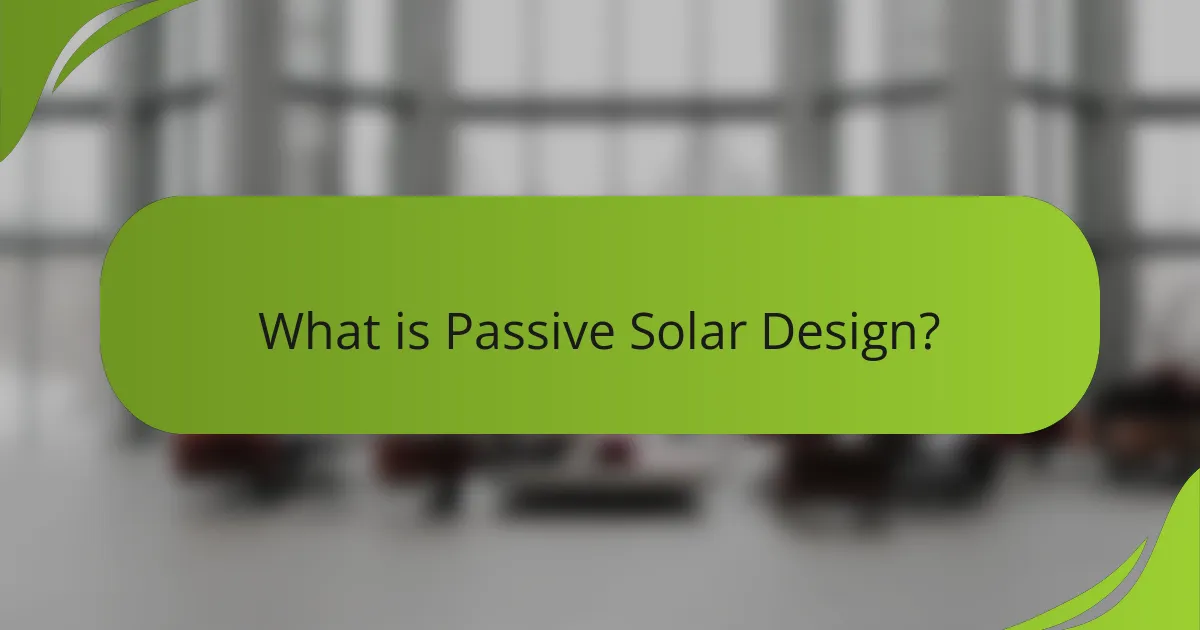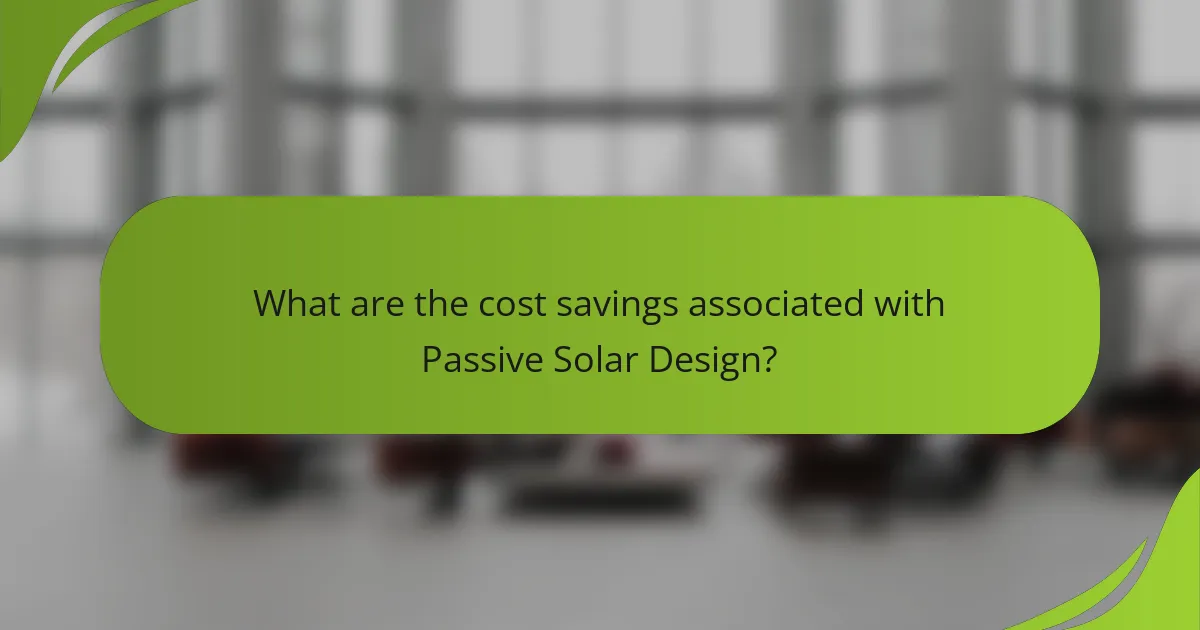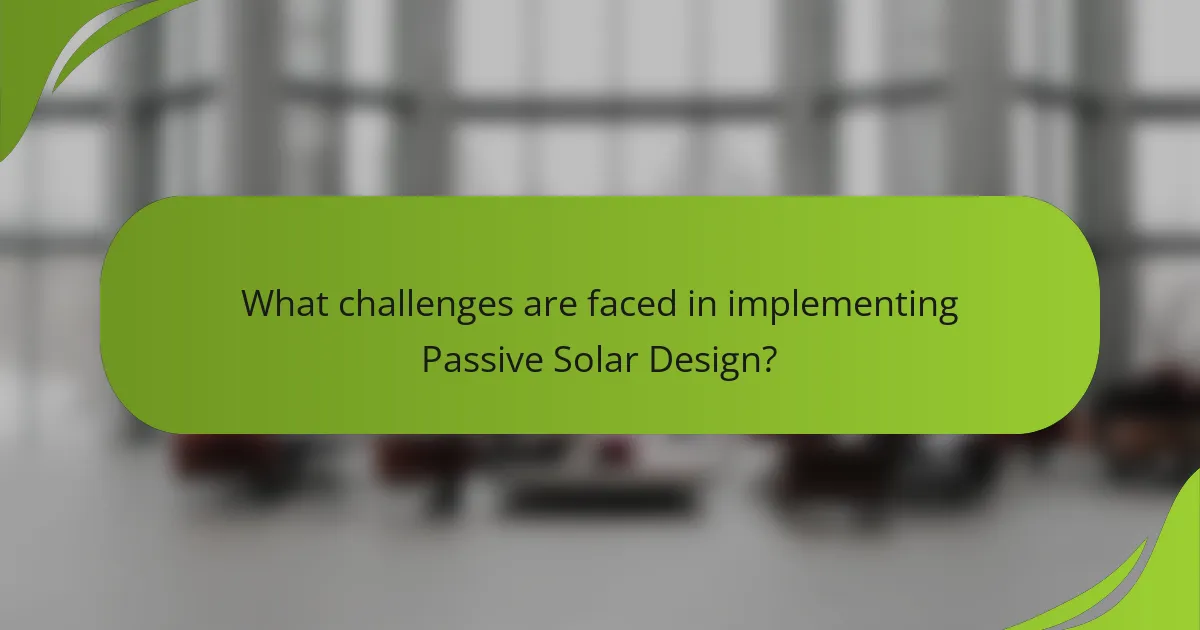Passive solar design is an architectural strategy that harnesses natural sunlight to efficiently heat and cool buildings, significantly reducing energy consumption. Key components of this design include the careful orientation of structures, optimal window placement, and the use of thermal mass materials to store and distribute solar energy. Research indicates that implementing passive solar design can lead to energy savings of up to 50%, enhancing indoor comfort while decreasing reliance on mechanical systems. Despite its advantages, challenges such as high initial costs, the need for specialized knowledge, site-specific factors, regulatory hurdles, and homeowner skepticism can hinder widespread adoption of this energy-efficient approach. The article will explore these key strategies, potential cost savings, and the obstacles faced in implementing passive solar design.

What is Passive Solar Design?
Passive solar design is an architectural approach that utilizes natural energy from the sun to heat and cool buildings. This design maximizes sunlight exposure through strategically placed windows and thermal mass materials. Key elements include orientation, window placement, and insulation. Research shows that passive solar design can reduce energy costs by up to 50%. Studies from the U.S. Department of Energy highlight its effectiveness in various climates. This method enhances indoor comfort while minimizing reliance on mechanical heating and cooling systems.
How does Passive Solar Design utilize natural energy?
Passive solar design utilizes natural energy by maximizing sunlight for heating and lighting. It incorporates building orientation, window placement, and thermal mass materials. These strategies allow buildings to capture and store solar energy effectively. For instance, south-facing windows can collect sunlight during the winter. Thermal mass materials, like concrete or brick, absorb heat during the day and release it at night. Research indicates that passive solar design can reduce heating costs by up to 50%. This method promotes energy efficiency and reduces reliance on fossil fuels.
What are the fundamental principles of Passive Solar Design?
The fundamental principles of Passive Solar Design focus on utilizing natural energy from the sun to maintain comfortable indoor temperatures. Key principles include orientation, which involves positioning buildings to maximize sunlight exposure. The use of thermal mass is essential; materials like concrete or brick absorb and store heat. Proper insulation is critical to minimize heat loss during colder months. Windows should be strategically placed for optimal daylighting while minimizing glare. Overhangs or shading devices can reduce heat gain in the summer. Ventilation strategies enhance air circulation and cooling. These principles are supported by studies indicating energy savings of up to 30% in well-designed passive solar homes.
How does orientation impact Passive Solar Design effectiveness?
Orientation significantly impacts the effectiveness of Passive Solar Design. Proper orientation maximizes solar gain during winter and minimizes heat during summer. South-facing windows capture the most sunlight in the Northern Hemisphere. This orientation allows for optimal thermal performance and natural lighting. Studies show that buildings with ideal orientation can reduce heating costs by up to 30%. Conversely, poor orientation can lead to increased energy consumption and discomfort. Therefore, understanding and implementing correct orientation is crucial for successful Passive Solar Design.
What are the key components of Passive Solar Design?
The key components of Passive Solar Design include orientation, thermal mass, insulation, and window placement. Orientation involves positioning a building to maximize sunlight exposure. Thermal mass refers to materials that absorb and store heat, such as concrete or stone. Insulation minimizes heat loss and maintains stable indoor temperatures. Window placement and size are critical for optimizing natural light and heat gain. These components work together to enhance energy efficiency and reduce heating and cooling costs. Studies show that well-designed passive solar homes can reduce energy consumption by up to 50%.
Which materials are best suited for Passive Solar Design?
Concrete materials are best suited for Passive Solar Design. These materials include concrete, brick, and stone. They have high thermal mass, which allows them to absorb and store heat. This heat can be released slowly, providing warmth during cooler periods. Additionally, materials like glass can enhance solar gain. Double or triple glazing improves insulation and reduces heat loss. Insulation materials, such as cellulose or spray foam, also play a crucial role. They help maintain interior temperatures by minimizing heat transfer. Using these materials effectively can optimize energy efficiency in passive solar buildings.
How do windows and shading devices contribute to Passive Solar Design?
Windows and shading devices are essential components of Passive Solar Design. They control solar heat gain and loss, optimizing indoor temperatures. Properly oriented windows can capture sunlight during winter, providing natural warmth. Shading devices, like overhangs or louvers, block excessive summer sun, reducing cooling needs. This balance minimizes reliance on mechanical heating and cooling systems. Research indicates that well-designed windows can improve energy efficiency by up to 30%. Effective shading can further enhance comfort and reduce energy costs. Therefore, integrating windows and shading devices is crucial for maximizing the benefits of Passive Solar Design.

What are the cost savings associated with Passive Solar Design?
Passive Solar Design can lead to significant cost savings on energy bills. By utilizing natural sunlight for heating and cooling, buildings reduce reliance on artificial heating and air conditioning. This can result in energy savings of up to 50% compared to conventional designs. Furthermore, initial investments in passive solar features often pay off within 5 to 10 years through reduced utility costs. Additionally, many regions offer tax incentives and rebates for implementing energy-efficient designs, further enhancing financial benefits. Studies show that homes designed with passive solar strategies have higher resale values, adding long-term financial advantages.
How does Passive Solar Design reduce energy bills?
Passive solar design reduces energy bills by maximizing natural heating and cooling. This design utilizes the sun’s energy for temperature regulation. It incorporates elements like large windows and thermal mass to absorb heat. During winter, sunlight warms the interior, decreasing heating costs. In summer, strategic shading prevents overheating, lowering cooling expenses. Research shows homes with passive solar design can save 30-50% on energy bills. This efficiency is achieved through careful planning and orientation of the building. The U.S. Department of Energy reports that passive solar techniques can significantly enhance energy performance.
What are the long-term financial benefits of implementing Passive Solar Design?
Implementing Passive Solar Design offers significant long-term financial benefits. These benefits primarily include reduced energy costs and increased property value. Homes designed with passive solar principles can lower heating and cooling expenses by up to 50%. This reduction occurs because the design maximizes natural light and thermal mass to maintain comfortable temperatures.
Additionally, passive solar homes often require less reliance on HVAC systems. This leads to lower maintenance costs and longer equipment lifespan. According to the U.S. Department of Energy, energy-efficient homes can appreciate more quickly than traditional homes.
Investing in passive solar design also qualifies homeowners for various tax incentives and rebates. These financial advantages contribute to a faster return on investment over time. Overall, the long-term savings on energy and maintenance, combined with increased property value, make passive solar design a financially sound choice.
How do initial costs compare to savings over time?
Initial costs for passive solar design can be higher than conventional building methods. However, over time, these costs are often offset by significant energy savings. Research indicates that buildings utilizing passive solar strategies can reduce energy bills by 30% to 50%. This reduction leads to a return on investment typically seen within 5 to 10 years. Additionally, the lifespan of these energy-efficient systems can exceed 30 years, providing long-term savings. Therefore, while initial expenses may be daunting, the cumulative financial benefits over time validate the investment.
What incentives are available for Passive Solar Design?
Incentives for Passive Solar Design include tax credits, rebates, and grants. Many states offer tax incentives for energy-efficient home improvements. Federal programs, such as the Energy Efficiency Tax Credit, can also apply. Additionally, utility companies may provide rebates for energy-efficient upgrades. Some local governments have grant programs for sustainable building practices. These incentives encourage homeowners to adopt passive solar design. They help reduce overall costs associated with implementation.
Which government programs support Passive Solar Design initiatives?
Various government programs support Passive Solar Design initiatives. The U.S. Department of Energy (DOE) offers the Solar Energy Technologies Office, which funds research and development. Additionally, the Federal Housing Administration (FHA) provides mortgage insurance for energy-efficient homes, including those utilizing passive solar design. State-level programs also exist, such as California’s Energy Upgrade California, which promotes energy-efficient home improvements. These programs aim to reduce energy consumption and promote sustainable building practices.
How can tax credits enhance the affordability of Passive Solar Design?
Tax credits can significantly enhance the affordability of Passive Solar Design. These financial incentives reduce the initial cost of implementing energy-efficient features. By lowering upfront expenses, tax credits make passive solar systems more accessible to homeowners. This encourages more individuals to invest in sustainable building practices. For example, federal tax credits can cover a percentage of installation costs for solar panels and energy-efficient windows. According to the U.S. Department of Energy, these incentives can lead to savings of thousands of dollars. Consequently, tax credits promote wider adoption of passive solar design, benefiting both the environment and the economy.

What challenges are faced in implementing Passive Solar Design?
Implementing Passive Solar Design faces several challenges. One major challenge is the initial cost of design and materials. High-quality materials for thermal mass and insulation can be expensive. Another challenge is the need for expert knowledge in design principles. Many architects and builders may lack experience in passive solar techniques. Site-specific factors also pose difficulties. Variations in climate and topography can affect the effectiveness of solar design. Additionally, regulatory hurdles can complicate implementation. Zoning laws and building codes may not support innovative designs. Lastly, homeowner resistance can hinder adoption. Some homeowners may be skeptical about the benefits of passive solar systems.
What are common obstacles in the design and construction process?
Common obstacles in the design and construction process include regulatory challenges, budget constraints, and communication issues. Regulatory challenges often arise from zoning laws and building codes that can delay projects. Budget constraints may limit the materials and technologies that can be used, affecting overall design quality. Communication issues between architects, engineers, and contractors can lead to misunderstandings and errors. Additionally, unforeseen site conditions can complicate construction efforts. Weather-related delays are also a frequent obstacle, impacting timelines and costs. These factors can significantly hinder the efficiency and effectiveness of the design and construction process.
How can site limitations affect Passive Solar Design implementation?
Site limitations can significantly impact the implementation of Passive Solar Design. Factors such as building orientation, shading from nearby structures, and topography can restrict solar access. For instance, a site with tall buildings to the south can block sunlight, reducing the effectiveness of solar gain. Additionally, sloped or uneven terrain may complicate the placement of solar features. Soil conditions can also influence the installation of thermal mass elements. According to the U.S. Department of Energy, optimal solar design requires careful site analysis to ensure adequate sun exposure. Therefore, site limitations directly affect the feasibility and efficiency of Passive Solar Design strategies.
What are the challenges related to building codes and regulations?
Building codes and regulations present several challenges in construction and design. First, they vary significantly by location, creating confusion for builders and architects. Compliance with these codes can increase project costs and extend timelines. Additionally, outdated codes may not accommodate modern sustainable practices. This hinders the implementation of passive solar design strategies. Furthermore, frequent changes in regulations require continuous education for industry professionals. Inconsistent enforcement of codes can lead to project delays and penalties. Lastly, navigating the permitting process can be time-consuming and complex, impacting overall project feasibility.
How can these challenges be overcome?
Challenges in passive solar design can be overcome through effective planning and integration of design strategies. First, thorough site analysis helps identify optimal solar exposure. Second, utilizing thermal mass materials can enhance heat retention. Third, proper window placement maximizes natural light while minimizing heat loss. Fourth, incorporating shading devices can control overheating during summer months. Fifth, engaging with experienced professionals ensures adherence to best practices. Lastly, educating stakeholders about benefits encourages investment in passive solar solutions. Research indicates that well-designed passive solar homes can reduce energy costs by up to 50%, demonstrating the effectiveness of these strategies.
What best practices can ensure successful Passive Solar Design projects?
Successful Passive Solar Design projects require careful planning and strategic implementation. First, site analysis is crucial. It helps identify solar access and prevailing winds. Orientation of the building should maximize sunlight exposure. South-facing windows capture the most solar energy. Thermal mass materials like concrete or stone store heat effectively. Proper insulation minimizes heat loss. Ventilation strategies enhance airflow and comfort. Landscaping can provide shade and reduce cooling costs. Utilizing energy-efficient windows improves overall performance. These best practices are supported by numerous studies, including the U.S. Department of Energy’s guidelines on passive solar design, which emphasize the importance of these strategies for energy efficiency.
How can collaboration with professionals enhance design outcomes?
Collaboration with professionals enhances design outcomes by integrating diverse expertise. Professionals bring specialized knowledge that improves design quality. For instance, architects can optimize space and aesthetics, while engineers ensure structural integrity. This multidisciplinary approach leads to innovative solutions. A study by the American Institute of Architects found that collaborative projects see a 30% increase in client satisfaction. Effective communication among team members fosters creativity and problem-solving. Ultimately, collaboration results in designs that are functional, sustainable, and aesthetically pleasing.
What practical tips can aid in the implementation of Passive Solar Design?
To effectively implement Passive Solar Design, focus on strategic placement of windows and overhangs. Orient windows to maximize sunlight exposure during winter months. Use thermal mass materials like concrete or stone to absorb and store heat. Insulate the building envelope to reduce heat loss. Incorporate shading devices to minimize overheating in summer. Utilize energy-efficient appliances and lighting to complement solar gains. Regularly assess the building’s energy performance to identify areas for improvement. These strategies enhance energy efficiency and reduce utility costs, aligning with sustainable building practices.
Passive Solar Design is an architectural approach that leverages natural sunlight to heat and cool buildings, significantly enhancing energy efficiency. The article outlines key strategies such as optimal building orientation, window placement, and the use of thermal mass materials, which can lead to energy savings of up to 50%. It also addresses the long-term financial benefits, including reduced energy bills and potential tax incentives, while highlighting challenges like initial costs and regulatory hurdles. Practical tips for successful implementation and collaboration with professionals are provided to ensure effective passive solar design outcomes.